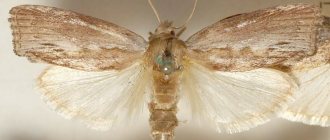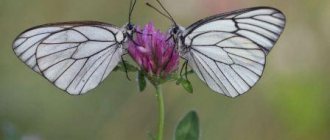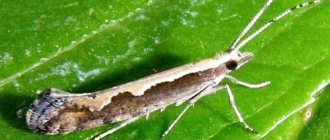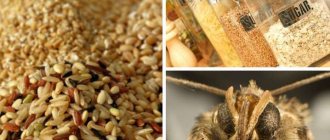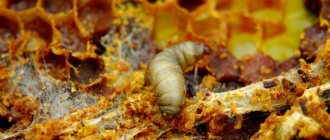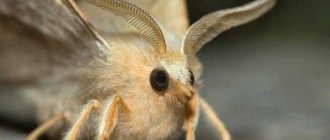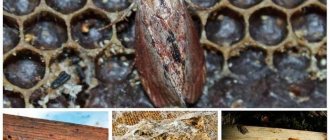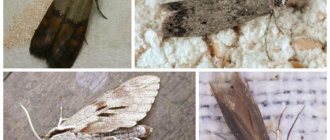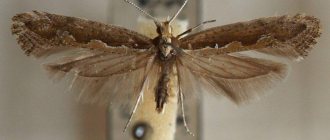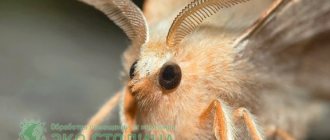Wax moth
Wax moth - bee moth Photo: wax moth - Galleria Mellonella
The large wax moth (Galleria Mellonella), a moth of the moth family (Pyralidae), is evolutionarily adapted to living in a beehive and is known to all beekeepers as a pest. Often the large wax moth is simply called a moth or a bee moth, which is not entirely true, since there are more than 6,000 species in the family of moths (Pyralidae), and in the family of bee moths (Galleriidae), in addition to the large one, there is also a small wax moth, the larvae of which have no medicinal properties . The bee moth is found wherever beekeeping is developed, mainly in the southern regions. Wax moths attack weak bee colonies or waxy raw materials, where they lay eggs, from which caterpillars emerge after 5-10 days. The caterpillars (larvae) of the large wax moth initially feed on beebread, pollen and honey. Then they eat the wax and remnants of the cocoons, and make passages entwined with cobwebs in the honeycombs, thereby damaging the honeycombs and dry land. Large wax moth larvae are the only living creatures that have the unique ability to digest and assimilate beeswax. Wax moth causes great harm to beekeeping.
What plants are threatened by insects?
To begin the fight against a harmful parasite, you need to find out the type of attacking moth.
| Variety | What crops does it affect? | Signs of defeat |
| Potato. | Potatoes, peppers, tomato, eggplant, tobacco. | Plants take on an anemic appearance, the foliage becomes covered with a thin cobweb. |
| Onion. | Onion garlic. | The leaves of the crop turn yellow and dry out, and the plant quickly dies. |
| Cabbage. | Cabbage, rutabaga, rapeseed, radish, mustard, radish, turnip. | The affected vegetable shrivels, the fruits begin to rot, the buds are eaten away, and holes appear on the leaves. |
| Tomato (mining). | All types of tomatoes. | Withering of plants, death and rotting of fruits. |
| Apple (ermine). | Fruit trees. | They eat the leaf mass, the leaves turn yellow, dry out, and can destroy up to 80% of the fruit harvest. |
| Grape (circle). | Vine plantings. | Oily patches appear on the foliage, and the vine gradually dries out and dies. |
| Wax (fire). | Bee hives. | Cobwebs appear on the bodies of bees, and their flight slows down. |
| Poplar. | Almost all green spaces and fruit trees. | The appearance of eaten away cavities on the foliage, the leaves acquire a mosaic color. |
| Rowan (variegated). | Rowan, apple trees. | Dark spots on the fruits, perforated leaves. |
| Bud (currant). | Raspberries, currants, blackberries. | The bushes become as if burned or frostbitten, the leaves wither and curl. |
There are species of moths that suck the tears of sleeping animals. The large Madagascar moth is famous for this.
Large and small wax moth
The large wax moth (Galleria Mellonella) and the small wax moth (Achroia Grisella) belong to the family of moths (Pyralidae), currently separated by entomologists into a separate family - wax moths (Galleriidae). Like most moths, large and small wax moths are small moths that are nocturnal and parasitic in bee hives and warehouses of wax raw materials.
Great wax moth (Galleria mellonella)
Females of the great wax moth butterfly have a length of 13-35 mm and a wingspan of 18-32 mm, males are smaller; their length is 9-13 mm, and their wingspan is 17-23 mm. The wings and body of butterflies are covered with scales; when at rest, the wings are folded into a “boat”. The forewings are violet-gray with brown spots in females and yellowish with red-brown spots in males. The hind wings are light gray (with an ash tint) and have dark strokes along the edges. The body of the butterfly (under the wings) is cream-colored. The head is elongated, gray or brown with large faceted eyes and a short proboscis. On the head of females there are long, straight and densely scaly labial palps. The number of males and females has a ratio of 1:1.14, characteristic of solitary insects. The oral and digestive organs of adult wax moths are not developed; they do not feed and live off the nutrients accumulated in the larval stage. The lifespan of females is 5-12 days, males up to 27 days. To lay eggs, females often choose hives with weak bee colonies, which they enter at night and leave before dawn. Females lay eggs in separate batches on the walls of cells with fresh pollen or honey, in the cracks of frames, on the walls or at the bottom of the hive. The eggs are oval in shape, white or light cream in color, smooth, 0.35 -0.5 mm in size. Over the course of her life, a female large wax moth can lay up to 3,000 eggs.
Variety of species
House moths are small insects whose wings are up to 7 mm long and form a triangle when folded. These pests differ in their color to a small extent, since for the most part they are quite inconspicuous and inconspicuous.
If we consider the ermine moth, it will differ not only in its bright color, but also in the way it folds its wings - it is no longer a triangle, but a pyramid. The wallflower also stands out for the colorfulness of its wings, which when folded look like a narrow tube.
Some pests have a unique color that helps them camouflage perfectly. This is necessary mainly for species living in the wild, since they are unable to fly long distances and they also lack any means of protection.
Great wax moth
Male and female Great Wax Moth Picture: Male and female Great Wax Moth (Galleria Mellonella)
Large wax moth larvae.
Lesser wax moth (Achroia grisella)
It is as common as the large wax moth. Females have a length of 7-12 mm and a wingspan of 15-23 mm, the length of males is 4.5-9 mm, their wingspan is 12-17 mm. The forewings of an adult butterfly are narrow, the hind wings are shorter and wider than the forewings. In a calm state, the wings are folded like a roof and slightly overlap each other at the ends. The color varies from ash-gray to dark yellow. On the forehead there is a patch of short yellow hairs. The butterfly's body is flat, its head is lowered. The mouthparts are undeveloped - butterflies do not feed. The number of males and females is approximately the same. The female small wax moth lays eggs in the cracks of the hive, less often in the cells of the honeycomb. The eggs are round or oval in shape, yellow-white in color, 0.2-0.35 mm in size. A female small moth can lay up to 400 eggs. Unlike the larvae of the large wax moth, the larvae of the small wax moth do not have medicinal properties.
Prevention measures
Moths can easily appear in any apartment, regardless of sanitary conditions. At the same time, she does not stay in every apartment due to unfavorable conditions. Since they cannot lay eggs under their usual conditions, they have nothing to do in such a dwelling. By following a number of very simple rules, you can reliably protect your home from pests.
You need to proceed as follows:
- Regularly ventilate closets where clothes are stored, and at the same time check things for the presence of such pests. Particular attention should be paid to items made of fur, leather, knitted items, and natural wool.
- Take things outside or onto the balcony if it is open. This can be done both in summer and winter. The larvae die both from ultraviolet rays and from sub-zero temperatures.
- Items made from natural fur should be stored correctly, without using polyethylene. To do this, use special covers, pre-treated with chemicals, or put leaves of tobacco, wormwood, lavender and other plants wrapped in gauze in your clothing pockets.
- Bulk food products also need to be stored properly in closed containers. Do not purchase bulk food products for a long period - a couple of weeks maximum. If cereals or flour are stored for a long time, then pests will definitely appear in them.
Lesser wax moth
Lesser wax moth male and female Picture: male and female Lesser wax moth (Achroia grisella)
Small wax moth larvae.
Beekeepers often confuse large and small wax moths, since the size and color of the moths are variable and depend on the qualitative composition of the honeycombs on which the insects feed in the larval stage and the temperature at which they develop.
What does it eat?
When a black moth is found in an apartment, many would like to know what this pest eats.
If you find a flying insect in the kitchen, you need to check the following products::
- bulk: cereals, sugar, flour;
- tea, coffee, cocoa;
- medicinal plants (teas, infusions);
- dried fruits;
- legumes (beans, peas, lentils);
- pasta;
- dry products (baby food, milk, cream);
- dry food for animals.
Moth larvae eat food, leaving behind webs and cocoons, which are shed after the moths emerge . The presence of such substances among products not only spoils their aesthetic appearance, but can also cause serious food poisoning if a person continues to consume contaminated products.
Medicinal properties of wax moth larvae
Recently, articles have appeared on the Internet claiming that wax moth products are a placebo, since there is no scientific justification or evidence of their effectiveness. Articles with such statements were written by incompetent people or out of ignorance (for example, on Wikipedia), or for the purpose of promotion in search engine results (for example, on a group of affiliated satellite sites about the control of domestic insects) and have nothing to do with real information about scientific research on medicinal products made from wax moth larvae do not have the properties and effectiveness of use.
The healing properties of wax moth larvae were known in ancient Asian countries and Egypt. In Russian folk medicine, from ancient times they were used to prepare remedies for the treatment of age-related changes and tuberculosis.
The first scientific studies of wax moth larvae date back to the end of the 19th century. The Russian scientist Nobel Prize winner I. I. Mechnikov drew attention to the ability of a folk remedy to cure tuberculosis. It was Mechnikov who first suggested that the larvae of bee moths (Galleria mellonella) may contain substances capable of lysing (destroying) the waxy membranes of tuberculosis bacteria.
Preventive actions
Preventive measures to protect food supplies from pests:
- Use of traps. They are sold in specialized stores or through a network of online stores. Odorless traps are especially suitable. These are produced by TM Raptor. They are made of cardboard with a layer of very sticky glue and pheromones. They are glued to the wall of the cabinet. The trap protects against pests for 90 days.
- Moderation in purchasing. Experienced housewives do not make large stocks, but buy fresh cereals every time. It is also important to check the expiration date. If the cereal has been stored in a warehouse for a long time, it may have nests of parasites. After purchasing a new portion of cereal, it is advisable to first warm it up or freeze it. Some people also decide to store grains in the freezer.
- Cleanliness and tidiness. It is advisable to thoroughly clean all cabinets every month. It is also useful to regularly ventilate the kitchen. Fluttering insects do not like fresh air and drafts.
- The pest can choose a secluded place under baseboards or on carpets, so it is important to thoroughly vacuum all crevices and darkened areas. And the larvae can colonize ceiling lamps and corners of window frames, so they should also be washed thoroughly.
- Ultraviolet irradiation helps get rid of harmful insects. Sunlight kills pests in just 60 minutes. Temperatures that are too high or low are lethal to the larvae. Moth eggs die at low temperatures within 24 hours. Things need to be dried and beaten out periodically.
The appearance of any type of moth is always very upsetting for owners. The fight against it will be effective if preventive measures are followed constantly, and not used as a one-time event.
If the housewife constantly monitors and checks the contents of the lockers, then she is guaranteed cleanliness and order.
Mechnikov I. I.
Mechnikov Ilya Ilyich (1845-1916) Photo: Mechnikov I. I. - the first researcher of the medicinal properties of wax moth
Mechnikov Ilya Ilyich (1845-1916) - Russian scientist Nobel laureate in physiology and medicine in 1908 “For his work on immunity.” Among I. I. Mechnikov’s numerous awards is the Copley Medal of the Royal Society of London, an honorary doctorate from the University of Cambridge, and he is also a member of the French Academy of Medicine, an honorary member of the St. Petersburg Academy of Sciences and Moscow University, and a member of the Swedish Medical Society. Mechnikov is one of the founders of evolutionary embryology, the discoverer of phagocytosis and intracellular digestion, the creator of the phagocytic theory of immunity, and the founder of scientific gerontology. Since 1887, head of the laboratory at the Pasteur Institute in Paris.
Mechnikov’s idea about the ability of wax moth larvae to destroy the membranes of tuberculosis bacteria formed the basis for a large series of studies by the Russian immunologist Professor S.I. Metalnikov. Metalnikov experimentally proved and substantiated that the high immunity of wax moth larvae to a number of microorganisms pathogenic for humans (causative agents of tuberculosis, diphtheria, tetanus, plague, etc.) is due to a specific enzyme - cerase, which breaks down wax.
Metalnikov S. I.
Metalnikov Sergey Ivanovich (1870-1946) Photo: Metalnikov S.I. - author of the name of the digestive enzyme of wax moth larvae: cerase
Metalnikov Sergei Ivanovich (1870-1946) - Russian scientist: biologist, zoologist, immunologist. Published more than 250 scientific papers in the field of comparative physiology of invertebrates, applied microbiology and immunology in Russian and Western European languages. Some of Metalnikov's works opened up new areas of research. In 1907–1908 worked in the laboratory of I. I. Mechnikov at the Pasteur Institute in Paris. Since 1919, he has been a permanent employee of the Pasteur Institute, where he studied the immunity of invertebrates (primarily insects) and the connection between immunity and the activity of the nervous system. The founder of psychoneuroimmunology, a new field of medicine. Author of the famous book “The Problem of Immortality and Rejuvenation in Modern Biology” (1924), dedicated to the phenomenon of aging of the body.
You can find many publications on the Internet, including on Wikipedia, in which the existence of the cerase enzyme is questioned and all authors of scientific papers on the medicinal properties of wax (bee) moth larvae are called “persons not known in either medical or biological circles.” " If the authors of such publications do not know the names of Mechnikov, Metalnikov and other scientists, as well as numerous publications (list of published scientific articles) in authoritative scientific publications, then a logical question arises - what relation do such authors have to medical and biological circles?
In addition to Metalnikov (the author of a large series of publications on the immunity of wax moth larvae: Metalnikov, 1906, 1907, 1908, 1915, 1921; Metalnikov, 1907, 1908, 1920, 1921, 1935) an enzyme preparation that has a destructive effect on tuberculosis bacteria and has high lipolytic activity in relation to the lipids of Mycobacterium tuberculosis (Koch's bacillus), Mankiewicz E. was isolated from the larvae of the great wax moth (Mankiewicz, 1949; 1952). The antimicrobial effect of wax moth larvae extract against Mycobacterium tuberculosis was also confirmed in the works of other authors (Olivier, 1947; Kuzniecow and Wojciechowski, 1950; Paszewski, 1959).
A large series of studies of the cerase enzyme was carried out by the Bosnian biochemist MK Muftic (Mahmud Kamal Muftic) at the Tuberculosis Research Institute (Borstel Center) in Schleswig-Holstein (Germany) and the Biochemical Laboratory at the University of Lausanne (Switzerland). Scientific work of MK Muftic on the study of the enzyme cerase and its activity against Mycobacterium tuberculosis in the period 1955-1970. published in authoritative scientific journals around the world (British Journal of Tuberculosis, Enzymologia, Tubercle, Indian Journal of Medical Sciences, Pathologia and Microbiologia, The Japanese journal of tuberculosis, etc.).
MK Muftic
Mahmud Kamal Muftic (1925-1975) Photo: MK Muftic – author of scientific works on the digestive enzyme of wax moth larvae
Mahmud Kamal Muftic (MK Muftic 1925-1975) - Bosnian biochemist, published about 40 articles on bacteriology (including tuberculosis) in medical journals around the world. He is a co-author of several patents owned by the German pharmaceutical company Schering AG (now Bayer AG). From the end of 1940 to the beginning of 1960, MK Muftic worked as a doctor and researcher in several countries of the Middle East (Egypt, Iran, Saudi Arabia). Since 1962 worked at the Tuberculosis Research Institute in Schleswig-Holstein, West Germany. Since the late 1960s, he has been employed in the biochemistry laboratory at the University of Lausanne in Switzerland and collaborated with the biochemistry department at Trinity College Dublin.
Modern studies of wax moth larvae extract, conducted at the Institute of Cell Biophysics of the Russian Academy of Sciences, confirm the existence in the high-molecular fraction of acidic serine protease (cerase enzyme), capable of dissolving cell membranes. According to researchers from the Institute of Cell Biophysics of the Russian Academy of Sciences, it is the proteolytic enzyme, serine protease, that plays a leading role in the resorption of blood clots and plaques in blood vessels and lung tissue, as well as in the regeneration of scar tissue after a heart attack.
A major contribution to the study of the medicinal properties of wax moth belongs to the Moscow cardiologist and homeopath S. A. Mukhin. Even in his youth, a folk remedy made from wax moth larvae helped him cope with his own illness - tuberculosis. In his works devoted to the treatment of cardiovascular diseases, S. A. Mukhin was able to scientifically substantiate and prove the prospects of using wax moth larvae extract in the treatment of atherosclerosis, cardiosclerosis, angina pectoris and myocardial infarction, as well as tuberculosis and senile diseases.
Mukhin S. A.
Mukhin Sergey Alekseevich (1905-1981) Photo: Mukhin S.A. - scientifically proved the effectiveness of wax moth extract in the treatment of cardiovascular diseases
Mukhin Sergey Alekseevich (1905-1981) – Russian scientist: homeopath, cardiologist. One of the founders of the Moscow homeopathic school. Since 1934, he worked at the Institute of Cardiology on his dissertation and was the best student of Professor D. D. Pletnev. Co-author of uniquely important works on atherosclerosis. Throughout his life, Mukhin studied ancient manuscripts of traditional medicine, which formed the basis of later pharmacology. Being a famous homeopath, Mukhin fought against the unfair persecution of homeopathy by official Soviet medicine. It is precisely because of the non-acceptance of homeopathic methods of treatment by official Soviet science that very little is known about the multifaceted research and achievements of S. A. Mukhin.
The amazing ability of wax moth larvae extract to restore tissue after deep morphological damage (to resolve fresh scars after a myocardial infarction, as well as to heal tuberculous cavities in the lungs and replace them with healthy tissue) was proven in the 1980s by Professor M. N. Kondrashova at the Institute of Biological Physics AH CCCP.
General composition of wax moth extract/tincture
Thanks to the unique diet of large wax moth larvae, which includes substrates rich in biologically active substances (breadbread, honey and beeswax containing propolis, as well as bee waste products: royal jelly, bee and drone brood), LVM extract has a complex and balanced chemical compound.
| Chemical compound | Content of wax moth larvae in the extract (% dry matter) |
| High molecular weight substances | 2 |
| Nucleotides and nucleosides | 1,5 |
| Free amino acids | 50-60 |
| Monosaccharides and disaccharides | 2-4,7 |
| Fatty acid | 0,1 |
| Minerals | 7,1-9,1 |
Full chemical composition of wax moth larvae extract.
Wax moth larvae extract contains a large amount of free amino acids, monosaccharides and disaccharides, nucleotide bases and their derivatives, fatty acids, biologically important elements and trace elements (potassium K, phosphorus P, copper Cu, manganese Mn, selenium Se, chromium Cr, molybdenum Mo, magnesium Mg, cobalt Co, calcium Ca, zinc Zn, iron Fe, etc.). The high molecular weight fraction of the extract contains acidic serine protease (cerase enzyme) and aromatic compounds associated with sugars and amino acids. The extract of wax moth larvae contains biologically active substances that stimulate the contractile activity of smooth muscles and accelerate the growth of cells and tissues.
Usually, when describing the valuable components of propolis, royal jelly or drone jelly, decenoic acids are especially emphasized. But few people know that the extract of wax moth larvae also contains decenoic acids , namely: oleic (cis-9-octadecenoic acid) and palmitoleic (cis-9-hexadecenoic acid) acids.
Decenoic acids are unsaturated fatty acids, found only in the body of bees and humans, secreted by the glands of bees and have no analogues in nature. Decenoic acids have high biological activity, an antiviral effect at the cellular level and a powerful anti-inflammatory effect. Decenoic acids are effective against the toxoplasma virus in the cells of the nervous system and liver, thereby helping to stabilize and regulate the nervous system and restore liver function.
Everything described above refers to a real extract (tincture) made from freshly collected wax moth larvae grown on natural food - dark waxy sushi with the remains of bees.
In the last few years, products have appeared on sale that are allegedly made from wax moth larvae, but in reality are not such. Some of these products are just pacifiers - placebos, and some are really dangerous to health. You can learn about how not to buy a fake or dummy instead of a real product made from wax moth larvae, why wax moth extract cannot be bought in a pharmacy, how the extract differs from a tincture, as well as about us and our experience, from the article “Wax moth - where to buy ?.
Application of extract and tincture of wax moth larvae
The list of diseases for which the extract/tincture of wax moth larvae is effective is constantly growing, as research into the medicinal properties of the larvae is being conducted by scientists from different countries. To date, the effectiveness of using LVM extract for the following diseases has been scientifically substantiated and clinically proven:
- tuberculosis of the lungs and other organs (tuberculosis of the lymphatic and digestive system, tuberculosis of bones and joints, tuberculosis of the genitourinary organs, skin, eyes, tuberculosis of the central nervous system, tuberculosis of the meninges, etc.);
- diseases of the cardiovascular system (atherosclerosis, myocardial infarction, coronary heart disease, angina pectoris, cardiosclerosis, cardiac arrhythmias, hypertension, myocarditis of various etiologies, vegetative-vascular dystonia, varicose veins and other diseases of the cardiovascular system);
- bronchopulmonary diseases (bronchitis, pneumonia, pleurisy, bronchial asthma, fungal diseases of the lungs, etc.);
- gynecological diseases (infertility, toxicosis of the first half of pregnancy, disorders of the structure of endometrial cells, anemia, menopausal disorders, placental insufficiency, etc.);
- andrological diseases (prostate adenoma, low sperm motility, male infertility, impotence, decreased libido, low testosterone levels, etc.);
- during the recovery period after operations and injuries (after extensive inflammatory processes, suppuration and surgical interventions);
- as a general strengthening agent that enhances immunity (extract/tincture of wax moth larvae is a powerful natural immunostimulant).
Read more about treatment with wax moth larvae extract in the section “Wax moth - treatment”.
It is worth especially noting that, despite its high efficiency, the extract/tincture of wax moth larvae has no side effects or contraindications, with the exception of individual intolerance. Also, taking the extract is compatible with most pharmacological drugs, including anti-tuberculosis antibiotics.
Take LVM extract/tincture drops (the number of drops depends on the disease, weight and age) dissolved in water (50-100 ml) 30-40 minutes before meals 2-3 times a day. The minimum course of admission is 3 months. For children 5-14 years old, courses last 21 days, then a break of 21 days. For adults 3 months daily.
You can learn more about the methods of using extract/tincture of wax moth larvae for various diseases, as well as calculate an individual dosage regimen online (depending on your disease, weight and age) using an interactive calculator in the “Wax moth - application” section.
Answers to questions about wax moths and LVM products
Is it possible for a 6-year-old child and an adult to take wax extract for prevention throughout the entire calendar year...
“For prevention, it is enough to take LVM extract 2 times a year for 3 months (for both children and adults).
For children under 14 years of age, the dosage is calculated by age, for adults by weight (adjusted for age). For a 6-year-old child - dosage of 10% LVM extract and dosage regimen: course 21 days, 6 drops 1 time per day, while observing the reaction - whether there are any skin rashes or..." More details...
I am a nursing mother (child is 1 year 9 months). Can I use wax moth tincture or extract as...
“A nursing mother can take LVM tincture/extract as an immunostimulant (the alcohol content in a single dose is insignificant), but 25% LVM extract is better, since the ethanol (alcohol) content in the final dose is minimal (some fermented milk products contain more ethanol), with a higher concentration of nutrients.
Take 1-2 drops per 10 kg of weight (for example, for a person weighing 60 kg..." Read more...
I am now being treated at a tuberculosis clinic for focal tuberculosis. Of course, I am also being treated with antibiotics. I want to take a course...
“There is an opinion that taking alcohol-containing extracts and tinctures and antibiotics are incompatible, since the effectiveness of antibiotics is reduced and various side effects occur.
However, an analysis of existing scientific research shows that for the most part this is a fictitious myth that does not have any evidence behind it. British researchers believe that the myth arose during the Second World War..." Read more...
Diagnosis of pulmonary sarcoidosis. Is wax moth extract effective for pulmonary sarcoidosis? And what is the regimen?
“The etiology and pathogenesis of pulmonary sarcoidosis are still unknown; genetic factors, disorders of reactivity and the immune system are of great importance.
The connection and closeness of this disease with tuberculosis has not yet been rejected; it is believed that it is necessary to undergo a course of anti-tuberculosis therapy. The course and dose of taking wax moth larvae extract in this case, as in the treatment of tuberculosis, is 5-8..." More details...
Tell me, please, does wax moth extract help with chronic cervical cystitis?
“According to feedback from our customers, LVM extract helps with cholecystitis, pancreatitis and cystitis.
If you combine it with taking antibiotics, it is better to take 25% extract or 50% homogenate of LVM, since they have a lower ethanol content in the final dose.” Read more…
Is wax moth tincture effective for thyroid dysfunction (both hypo- and hyper-function)? How to use?
“From the reviews of the use of the LVM extract by our customers who took the LVM extract/tincture for disorders of the thyroid gland, there is a therapeutic effect.
Good results were achieved when combined with a tincture of dead bees. Dosage of LVM extract/tincture for disorders of the thyroid gland, as a general tonic. You can calculate your individual dosage regimen using..." Read more...
Is it possible to use wax moth larvae extract for autoimmune diseases? Does the extract help with...
“The mechanism of development of autoimmune diseases has not been fully studied, but if we assume that autoimmune diseases are caused by dysfunction of the immune system, then its use is quite possible.
From reviews of the use of LVM extract by our customers, we can note cases of resorption of benign tumors: lipomas, mastopathy, fibroids (including non-operable ones) and a decrease in the number of skin lesions...” Read more…
The child is 2 years old, often suffers from bronchitis and acute respiratory infections, the doctor advised him to take 2 drops a day of wax moth tincture 10%,…
“It is advisable to give children not the tincture, but a 10% extract of wax moth larvae (the tincture can cause allergic reactions).
For a 2-year-old child - dosage and regimen: course 21 days, 2 drops 1 time per day, while monitoring the reaction - for skin rashes or other manifestations of individual intolerance; then a break of 21 days; if tolerated normally, repeat the course (break..." More details...
When treating symptoms of darkening in the lungs, I drank your LVM extract for six months. Blood tests showed good results, x-ray...
“Take in prophylactic doses.
Calculate the dosage using the online calculator, select “Take as a preventative, general strengthening, immunity-boosting agent.” Read more…
Where does it come from in the apartment?
Black moths often appear in an apartment by accident. Enters through an open window and then finds a secluded place for himself. People often bring it along with store-bought cereal.
There may be no worms at the time of purchase, but after some time moths will begin to flutter around the kitchen. If you examine these cereal packages, they are filled with caterpillars and moths.
Often cereals become infected in the warehouse due to the fault of workshop workers. When a person brings such grains home, ideal conditions are created for moths. Sometimes infection also occurs from unscrupulous neighbors. Pests enter through vents, drains, or other pathways.
